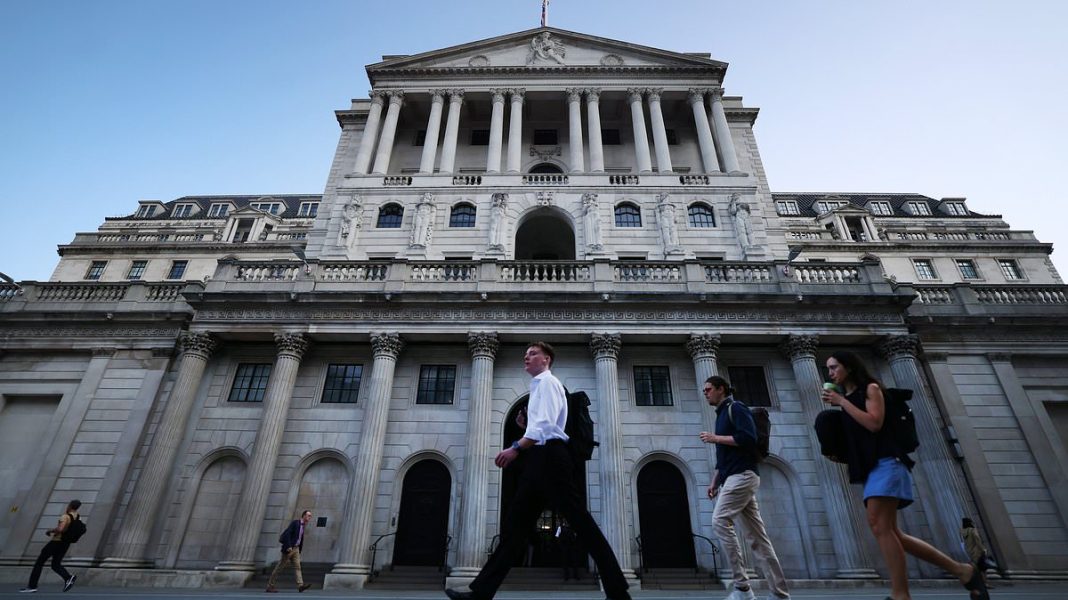The Bank of England kept UK interest rates at 4.25 per cent today amid rising food inflation and the threat of surging oil prices pushing up the cost of living.
Most economists had predicted that the Bank’s Monetary Policy Committee (MPC) would opt to keep rates on hold following its latest meeting.
Six members opted to hold and three preferred to cut, with the MPC saying a ‘gradual and careful approach’ to reducing borrowing costs was still the right course of action.
Bank governor Andrew Bailey added: ‘Interest rates remain on a gradual downward path, although we’ve left them on hold today. The world is highly unpredictable.’
He also said that there were ‘signs of softening in the labour market’ – referring to indicators including slower hiring and wage growth easing – which were being closely watched to see how far they feed into UK inflation.
The committee said it was alert to concerns about conflict in the Middle East, which has escalated in recent days with attacks between Israel and Iran.
In the minutes of the MPC’s meeting, it noted that there had been ‘rapid geopolitical developments’, adding: ‘Energy prices had risen owing to an escalation of the conflict in the Middle East.
‘The committee would remain vigilant about these developments and their potential impact on the UK economy.’
It echoes similar remarks made by the US’s central bank which also opted to keep interest rates on hold yesterday.
Global oil and natural gas prices have surged in recent weeks, which threatens to push up energy costs in the UK.
Furthermore, the MPC noted that Donald Trump’s tariff policy was posing risks to global trade and continuing to create uncertainty.
But it said that deals struck between the US and other countries, including the UK, meant that the direct impact of the ‘trade shock’ on global growth could be smaller than it had forecast last month.
Three members of the MPC – Swati Dhingra, Dave Ramsden and Alan Taylor – voted to reduce the rate by 0.25 percentage points to 4 per cent.
The decision to keep rates on hold came as UK Consumer Price Index (CPI) inflation remained above the Bank’s 2 per cent target level, coming in at 3.4 per cent last month.
The jobs market was also starting to cool, with the rate of unemployment ticking up and pay growth starting to ease.
The Bank said its network of agents had found that cost pressures from the beginning of April – including national insurance contributions rising – had put pressure on firms to recover them by raising prices.
As well as price hikes, it noted that businesses had been leaning on other actions to mitigate costs, including reducing their workforce, staff hours, salaries, and absorbing into profits.
It also pointed to waning business sentiment amid weak growth in the UK economy, with demand not expected to recover until 2026.
The MPC has voted to cut rates at every other meeting since it started easing borrowing costs last August, from a peak of 5.25 per cent.
This has been possible while the rate of UK inflation has been steadily falling from the highs reached in 2023, at the peak of the cost-of-living crisis.
Interest rates are used as a tool to put a lid on unruly inflation, in line with the Bank’s task of keeping the rate of Consumer Prices Index (CPI) at 2 per cent.
However, rising food prices have been putting pressure on overall inflation recently, with the latest data from the Office for National Statistics (ONS) showing food and non-alcoholic drink prices rose by 4.4 per cent in the year to May.
This was the highest level in more than a year, with items like ice cream, coffee, cheese and meat spiking last month.
Chocolate prices soared by nearly 18 per cent annually, a record jump for the confectionery.
The overall CPI rate came in at 3.4 per cent in May, slightly higher than the 3.3 per cent rate most economists had been expecting.
Mark Hicks, head of active savings at Hargreaves Lansdown, said: ‘Savings rates are likely to hold relatively firm. Variable rates owe a lot to the Bank of England, so a hold means less movement in the market.
‘Fixed rates, meanwhile, are being pulled in two different directions, so lack of movement here hides the fact there’s a lot going on.
‘The markets are expecting two more rate cuts this year, so all other things being equal this would put downwards pressure on savings rates.
‘However, at the same time, the bond market is busy putting upwards pressure on savings rates. It means little movement in the savings market, with small tweaks in one direction or the other.
‘It also makes forecasting harder. An awful lot depends on global politics, which has proven incredibly difficult to predict in recent months.
‘It means that instead of trying to second-guess global political developments, it makes sense to pick the right type of savings account for your needs and checking online banks and savings platforms for the best possible deals.’






